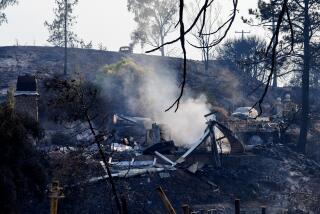1-Man Weather Bureau Aids Fellow Firefighters
RANCHO SANTA MARGARITA — With an eye toward darkening skies--and a laptop computer that plugs into a network of satellites and ground monitors--Pete Curran is the Orange County Fire Authority’s best chance of avoiding the elements of surprise.
The South County fire paramedic and self-described “weather geek” is a one-man forecasting center for his agency, using high-tech gear to divine the flooding threat of winter storms and predict hot winds that fuel wildfires.
Weather is a hobby that has turned into a part-time career for the 38-year-old San Clemente resident. Curran’s time is split between riding off to emergency calls and his weather work, and if a major storm or fire crisis hits, he rushes off to provide fire officials with the most current data.
“If we know where the danger is, where the danger is heading, we can use our resources effectively,” Curran said. “Forecasting can help. ‘Nowcasting,’ telling them what’s happening right now, can help.”
Curran’s weather center is a modest back room at Fire Station No. 45, a room with an outdated personal computer and a door sign made with masking tape and a marker.
But the setup, along with Curran’s laptop computer, allows him to tap into the National Weather Service’s countywide network of rain and flood sensors and a Doppler radar center on a nearby hillside. Curran compiles the data and, with his knowledge of local weather and emergency services, advises his agency’s tactical leaders.
“He’s a hell of an asset for us,” said Battalion Chief Marc Hawkins. “He knows how to communicate, he has an understanding of the weather and also fire service terms and what we’re looking for. He’s really found a niche.”
From his computer, for example, Curran can determine the up-to-the-minute wind speed and direction when Santa Ana winds ratchet up fire danger in the summer. Likewise, in the winter, Curran can see water levels rising at any of the major creeks in the county, allowing the department’s swift-water rescue teams to focus their patrols.
The creek levels are monitored by four dozen sensors in county waterways and flood channels, all operated by the county Environmental Management Agency. The EMA also has about 80 rainfall sensors throughout the county, each reporting to Curran. When combined with the radar and weather service advisories, the sensors can provide a vivid snapshot of conditions countywide.
“The weather is one more piece of the puzzle for emergency services,” Curran said. “It’s a good feeling to be able to take something I’m interested in and use it to help others.”
The Irvine native first became interested in weather when he was using short-wave radios in the early 1990s. He used radio to capture complex weather-imaging information, but then didn’t know how to decipher it. He bought books, took a course and, eventually, began correspondence work toward a meteorology degree from Mississippi State University.
Curran put his hobby to work for the first time during the mudslides and flooding that followed the Laguna Beach wildfire in October 1993. The huge blaze cleared away the brush and plants that help keep hillsides intact, and Curran--then working for the San Clemente Fire Department--became a technical advisor on weather for Laguna fire and city officials.
One of his recommendations: Don’t postpone the evacuation of a preschool on Laguna Canyon Road. Rainfall was piling up in the area, Curran’s findings showed. Several hours later, the evacuated school was completely flooded.
“The data worked,” he said. “That was a great feeling.”
*
Curran’s labors have been noticed.
He is on call to join the Fire Authority’s tactical leaders if a major storm or wind crisis hits. The Federal Emergency Management Agency included his job description in a national bulletin on techniques to improve disaster services. And Battalion Chief Hawkins has talked to state and other local agencies who are interested in collaborating with--or duplicating--the one-man program.
“He’s one of a kind right now,” Hawkins said. “And we’re fortunate we have him.”
Curran said his value to the department goes beyond his help with wind and water dangers.
“Everyone in the department calls me now,” he said with a grin. “‘Hey, how’s the surfing today?’ or ‘I’m going to Hawaii this weekend, will it rain?’ That’s what happens when you’re labeled a weather geek.”
More to Read
Sign up for Essential California
The most important California stories and recommendations in your inbox every morning.
You may occasionally receive promotional content from the Los Angeles Times.










